Behavioral evidence of chemical communication by male caudal fin organs of a glandulocaudine fish (Teleostei: Characidae)
Received 8 October 2019
Revised 30 December 2019
Accepted 17 July 2020
Published 23 September 2020
ZooBank LSID:
urn:lsid:zoobank.org:pub:483EB8ED-1D49-4584-9030-DE92226A6771
German National Library URN:
urn:nbn:de:101:1-2020092314571652158030
DOI:
10.23788/IEF-1127
10,50 €
Arbuckle, W. J., A. J. Bélanger, L. D. Corkum, B. S. Zielinski, W. Li, S.-S. Yun, S. Bachynski & A. P. Scott. 2005. In vitro biosynthesis of novel 5β-reduced steroids by the testis of the round goby, Neogobius melanostomus. General and Comparative Endocrinology, 140: 1-13.
Atkins, D. L. & W. L. Fink. 1979. Morphology and histochemistry of the caudal gland of Corynopoma riisei Gill. Journal of Fish Biology, 14: 465-469.
Azevedo, M. A., C. B. Fialho & L. R. Malabarba. 2016. Reproductive strategies in two inseminating species of Glandulocaudini, Mimagoniates microlepis and Mimagoniates rheocharis (Characiformes: Characidae: Stevardiinae). Journal of Fish Biology, 89: 431-444.
Azevedo, M. A., L. R. Malabarba & C. B. Fialho. 2000. Reproductive biology of the inseminating glandulocaudine Diapoma speculiferum Cope (Teleostei: Characidae). Copeia, 2000: 983-989.
Azevedo, M. A., L. R. Malabarba & J. R. Burns. 2010. Reproductive biology and development of gill glands in the inseminating characid, Macropsobrycon uruguayanae Eigenmann, 1915 (Cheirodontinae: Compsurini). Neotropical Ichthyology, 8: 87-96.
Barata, E. N., R. M. Serrano, A. Miranda, R. Nogueira, P. C. Hubbard & A. V. M. Canário. 2008. Putative pheromones from the anal glands of male blennies attract females and enhance male reproductive success. Animal Behaviour, 75: 379-389.
Bélanger, A. J., W. J. Arbuckle, L. D. Corkum, D. B. Gammon, W. Li, A. P. Scott & B. S. Zielinski. 2004. Behavioural and electrophysiological responses by reproductive female Neogobius melanostomus to odours released by conspecific males. Journal of Fish Biology, 65: 933-946.
Betancur-R, R., E. O. Wiley, G. Arratia, A. Acero, N. Bailly, M. Miya, G. Lecointre & G. Ortí. 2017. Phylogenetic classification of bony fishes. BMC Evolutionary Biology, 17: 1-140.
Burns, J. R. & S. H. Weitzman. 1996. Novel gill-derived gland in the male swordtail characin, Corynopoma riisei (Teleostei: Characidae: Glandulocaudinae). Copeia, 1996: 627-633.
Burns, J. R. & S. H. Weitzman. 2005. Insemination in ostariophysan fishes. Pp. 107-134 in: H. J. Grier & M. C. Uribe (eds.), Viviparous Fishes. Volume 11. New Life, Homestead.
Burns, J. R., S. H. Weitzman, H. J. Grier & N. A. Menezes. 1995. Internal fertilization, testis and sperm morphology in Glandulocaudine fishes (Teleostei, Characidae, Glandulocaudinae). Journal of Morphology, 224: 131-145.
Burns, J. R., S. H. Weitzman & L. R. Malabarba. 1997. Insemination in eight species of cheirodontine fishes (Teleostei: Characidae: Cheirodontinae). Copeia, 1997: 433-438.
Burns, J. R., S. H. Weitzman, L. R. Malabarba & A. Downing-Meisner. 2000. Sperm modifications in inseminating Ostariophysan fishes, with new documentation of inseminating species. P. 255 in: B. Norberg et al. (eds.), Proceedings of the 6th International Symposium on the Reproductive Fisiology of Fish. Institute of Marine Research and University of Bergen, Bergen.
Bushmann, P. J., J. R. Burns & S. H. Weitzman. 2002. Gill-derived glands in glandulocaudine fishes (Teleostei: Characidae: Glandulocaudinae). Journal of Morphology, 253: 187-195.
Castro, R. M. C., A. C. Ribeiro, R. C. Benine & A. L. A. Melo. 2003. Lophiobrycon weitzmani, a new genus and species of glandulocaudine fish (Characiformes: Characidae) from the rio Grande drainage, upper rio Paraná system, southeastern Brazil. Neotropical Ichthyology, 1: 11-19.
Colombo, L., A. Marconato, P. C. Belvedere & C. Friso. 1980. Endocrinology of teleost reproduction: a testicular steroid pheromone in the black goby, Gobius jozo L. Bollettino di Zoologia, 47: 355-364.
Crow, R. T. & N. R. Liley. 1979. A sexual pheromone in the guppy, Poecilia reticulata (Peters). Canadian Journal of Zoology, 57: 184-188.
Ferreira, K. M., N. A. Menezes & I. Quagio-Grassiotto. 2011. A new genus and two new species of Stevardiinae (Characiformes: Characidae) with a hypothesis on their relationships based on morphological and histological data. Neotropical Ichthyology, 9: 281-298.
Gammon, D. B., W. Li, A. P. Scott, B. S. Zielinski & L. D. Corkum. 2005. Behavioural responses of female Neogobius melanostomus to odours of conspecifics. Journal of Fish Biology, 67: 615-626.
Garber, J. C., R. W. Barbee, J. T. Bielitzki, L. Clayton, J. Donovan, C. Hendriksen, D. Kohn, N. Lipman, P. Locke & J. Melcher. 2011. Guide for the care and use of laboratory animals. National Academies, Washington D.C.
Gaskett, A. C. 2007. Spider sex pheromones: emission, reception, structures, and functions. Biological Reviews, 82: 27-48.
Géry, J. 1977. Characoids of the world. T.F.H., Neptune City, 672 pp.
Gonçalves T. K., M. A. Azevedo, L. R. Malabarba & C. B. Fialho. 2005. Reproductive biology and development of sexually dimorphic structures in Aphyocharax anisitsi (Ostariophysi: Characidae). Neotropical Ichthyology, 3: 433-438.
Javonillo, R., J. R. Burns & S. H. Weitzman. 2009. Sperm modifications related to insemination, with examples from the Ostariophysi. Pp. 723-763 in: A. B. G. M. Jamieson (ed.), Reproductive biology and phylogeny of fishes. Volume 8. Science, Enfield.
Javonillo, R., L. R. Malabarba, S. H. Weitzman & J. R. Burns. 2010. Relationships among major lineages of characid fishes (Teleostei: Ostariophysi: Characiformes), based on molecular sequence data. Molecular Phylogenetics and Evolution, 54: 498-511.
Kutaygil, D. L. 1959. Insemination, sexual differentiation and secondary sex characters in Stevardia albipinnis Gill. Hydrobiology University Istanbul Fen Fakültesi Mecmuasi, 24: 93-128.
Lambert, J. G. D. & J. W. Resink. 1991. Steroid glucuronides as male pheromones in the reproduction of the African catfish Clarias gariepinus – a brief review. The Journal of Steroid Biochemistry and Molecular Biology, 40: 549-556.
Li, W., A. P. Scott, M. J. Siefkes, H. Yan, Q. Liu, S.-S. Yun & D. A. Gage. 2002. Bile acid secreted by male sea lamprey that acts as a sex pheromone. Science, 296: 138-141.
Locatello, L., C. Mazzoldi & M. B. Rasotto. 2002. Ejaculate of sneaker males is pheromonally inconspicuous in the black goby, Gobius niger (Teleostei, Gobiidae). Journal of Experimental Zoology, 293: 601-605.
Loir, M., C. Cauty, P. Planquette & P.-Y. Le Bail. 1989. Comparative study of the male reproductive tract in seven families of South-American catfishes. Aquatic Living Resour, 2: 45-56.
Malabarba, L. R. 1998. Monophyly of the Cheirodontinae, characters and major clades (Ostariophysi: Characidae). Pp. 193-233 in: L. R. Malabarba et al. (eds.), Phylogeny and classification of Neotropical fishes. Edipucrs, Porto Alegre.
Meisner, A. D., J. R. Burns, S. H. Weitzman & L. R. Malabarba. 2000. Morphology and histology of the male reproductive system in two species of internally inseminating South American catfishes, Trachelyopterus lucenai and T. galeatus (Teleostei: Auchenipteridae). Journal of Morphology, 246: 131-141.
Menezes, N. A. & S. H. Weitzman. 1990. Two new species of Mimagoniates (Teleostei: Characidae: Glandulocaudinae), their phylogeny and biogeography and a key to the glandulocaudin fishes of Brazil and Paraguay. Proceedings of the Biological Society of Washington, 103: 380-426.
Menezes, N. A. & S. H. Weitzman. 2009. Systematics of the Neotropical fish subfamily Glandulocaudinae (Teleostei: Characiformes: Characidae). Neotropical Ichthyology, 7: 295-370.
Meyer, J. H. & N. R. Liley. 1982. The control of production of a sexual pheromone in the female guppy, Poecilia reticulata. Canadian Journal of Zoology, 60: 1505-1510.
Mirande, J. M. 2018. Morphology, molecules and the phylogeny of Characidae (Teleostei, Characiformes). Cladistics, 35: 282-300.
Nelson, K. 1964a. Behavior and morphology in the Glandulocaudine fishes (Ostariophysi, Characidae). University of California Publications in Zoology, 75: 59-152.
Nelson, K. 1964b. The evolution of a pattern of sound production associated with courtship in the characid fish, Glandulocauda inequalis. Evolution, 18: 526-540.
Nelson, K. 1964c. The temporal patterning of courtship behaviour in the Glandulocaudine fishes (Ostariophysi, Characidae). Behaviour, 24: 90-145.
Oliveira, C., G. S. Avelino, K. T. Abe, T. C. Mariguela, R. C. Benine, G. Ortí, R. P. Vari & R. M. C. Castro. 2011. Phylogenetic relationships within the speciose family Characidae (Teleostei: Ostariophysi: Characiformes) based on multilocus analysis and extensive ingroup sampling. BMC Evolutionary Biology, 11: 1-25.
Oliveira, C. L. C., L. R. Malabarba & J. R. Burns. 2012. Comparative morphology of gill glands in externally fertilizing and inseminating species of cheirodontine fishes, with implications on the phylogeny of the family Characidae (Actinopterygii: Characiformes). Neotropical Ichthyology, 10: 349-360.
Pfeiffer, W. 1963. Alarm substances. Experientia, 19: 113-123.
Pfeiffer, W. 1967. Schreckreaktion und Schreckstoffzellen bei Kneriidae und Phractolaemidae (Isospondyli, Pisces). Naturwissenschaften, 54: 177.
Pfeiffer, W. 1977. The distribution of fright reaction and alarm substance cells in fishes. Copeia, 1977: 653-665.
Quagio-Grassiotto, I., L. R. Malabarba, M. A. Azevedo, J. R. Burns, C. M. Baicere-Silva & R. Quevedo. 2012. Unique derived features in spermiogenesis and sperm morphology supporting a close relationship between the species of Hollandichthys and Rachoviscus (Characiformes: Characidae). Copeia, 2012: 609-625.
Resink, J. W., R. van den Hurk, R. F. O. Groeninx van Zoelen & E. A. Huisman. 1987. The seminal vesicle as source of sex attracting substances in the African catfish, Clarias gariepinus. Aquaculture, 63: 115-127.
Resink, J. W., P. K. Voorthuis, R. van den Hurk, R. C. Peters & P. G. W. J. van Oordt. 1989. Steroid glucuronides of the seminal vesicle as olfactory stimuli in African catfish, Clarias gariepinus. Aquaculture, 83: 153-166.
Serrano, R. M., E. N. Barata, M. A. Birkett, P. C. Hubbard, P. S. Guerreiro & A. V. M. Canário. 2008a. Behavioral and olfactory responses of female Salaria pavo (Pisces: Blenniidae) to a putative multi-component male pheromone. Journal of Chemical Ecology, 34: 647-658.
Serrano, R. M., O. Lopes, P. C. Hubbard, J. Araújo, A. V. M. Canário & E. N. Barata. 2008b. Seasonal cell differentiation and olfactory potency of secretions by the anal glands of male peacock blenny Salaria pavo. Journal of Fish Biology, 73: 1790-1798.
Shrestha, B., R. Javonillo, J. R. Burns, Z. Pirger & A. Vertes. 2013. Comparative local analysis of metabolites, lipids and proteins in intact fish tissues by LAESI mass spectrometry. Analyst, 138: 3444-3449.
Siefkes, M. J., A. P. Scott, B. Zielinski, S.-S. Yun & W. Li. 2003. Male sea lampreys, Petromyzon marinus L., excrete a sex pheromone from gill epithelia. Biology of Reproduction, 69: 125-132.
Sorensen, P. W. & N. E. Stacey. 2004. Brief review of fish pheromones and discussion of their possible uses in the control of non-indigenous teleost fishes. New Zealand Journal of Marine and Freshwater Research, 38: 399-417.
Spadella, M. A., C. Oliveira, H. Ortega, I. QuagioGrassiotto & J. R. Burns. 2012. Male and female reproductive morphology in the inseminating genus Astroblepus (Ostariophysi: Siluriformes: Astroblepidae). Zoologischer Anzeiger, 251: 38-48.
Spadella, M. A., C. Oliveira & I. Quagio-Grassiotto. 2008. Morphology and histology of male and female reproductive systems in the inseminating species Scoloplax distolothrix (Ostariophysi: Siluriformes: Scoloplacidae). Journal of Morphology, 269: 1114-1121.
Stacey, N. 2003. Hormones, pheromones and reproductive behavior. Fish Physiology and Biochemistry, 28: 229-235.
Stacey, N. & P. Sorensen. 2006. Reproductive pheromones. Pp. 359-412 in: K. A. Sloman et al. (eds.), Behaviour and physiology of fish. Volume 24. Elsevier Academic, Amsterdam.
Thomaz, A. T., D. Arcila, G. Ortí & L. R. Malabarba. 2015. Molecular phylogeny of the subfamily Stevardiinae Gill, 1858 (Characiformes: Characidae): classification and the evolution of reproductive traits. BMC Evolutionary Biology, 15: 146-171.
van den Hurk, R. V. D. & J. G. D. Lambert. 1983. Ovarian steroid glucuronides function as sex pheromones for male zebrafish, Brachydanio rerio. Canadian Journal of Zoology, 61: 2381-2387.
von Ihering, R. 1937. Oviductal fertilization in the South American catfish, Trachycorystes. Copeia, 1937: 201-205.
Ward, A. J. W., M. M. Webster & P. J. B. Hart. 2007. Social recognition in wild fish populations. Proceedings of the Royal Society B, 274: 1071-1077.
Weitzman, S. H. & S. V. Fink. 1985. Xenurobryconin phylogeny and putative pheromone pumps in glandulocaudine fishes (Teleostei: Characidae). Smithsonian Contributions to Zoology, 421: 1-121.
Weitzman, S. H. & N. A. Menezes. 1998. Relationships of the tribes and genera of the Glandulocaudinae (Ostariophysi: Characiformes: Characidae) with a description of a new genus, Chrysobrycon. Pp. 171-192 in: L. R. Malabarba et al. (eds.), Phylogeny and classification of Neotropical fishes. Edipucrs, Porto Alegre.
Weitzman, S. H., N. A. Menezes, H.-G. Evers & J. R. Burns. 2005. Putative relationships among inseminating and externally fertilizing characids, with a description of a new genus and species of Brazilian inseminating fish bearing an anal-fin gland in males (Characiformes: Characidae). Neotropical Ichthyology, 3: 329-360.
Sie müssen angemeldet sein, um eine Rezension veröffentlichen zu können.
„*“ zeigt erforderliche Felder an
Ähnliche Produkte
-
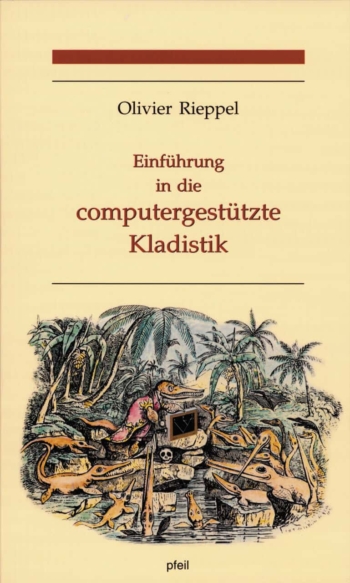
Einführung in die computergestützte Kladistik
13,00 €zzgl. Versandkosten / Versandkostenfrei in D
-
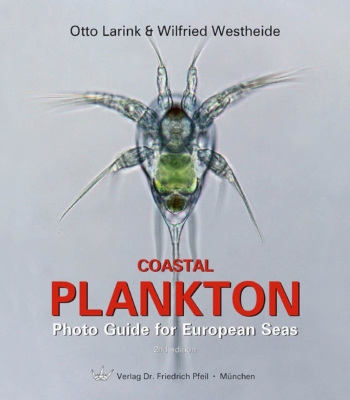
Coastal Plankton
38,00 €zzgl. Versandkosten / Versandkostenfrei in D
-
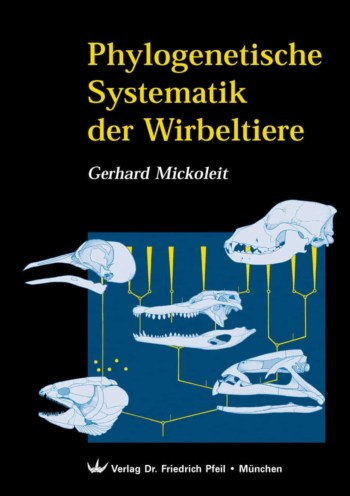
Phylogenetische Systematik der Wirbeltiere
98,00 €zzgl. Versandkosten / Versandkostenfrei in D
-
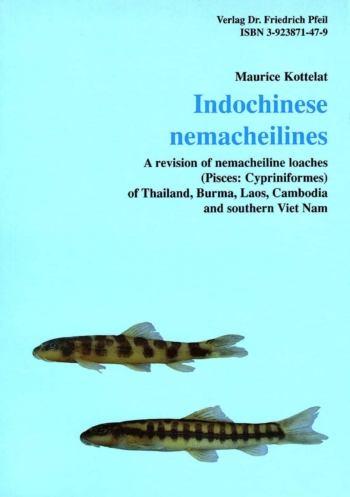
Indochinese nemacheilines
25,00 €zzgl. Versandkosten / Versandkostenfrei in D
Wir sind gerne für Sie da
Verlag Dr. Friedrich Pfeil
Hauptstraße 12B
5232 Bergkirchen OT Günding – Germany
Tel.: +49 8131 61 46 590
Fax: +49 8131 61 46 591
E-Mail: info@pfeil-verlag.de
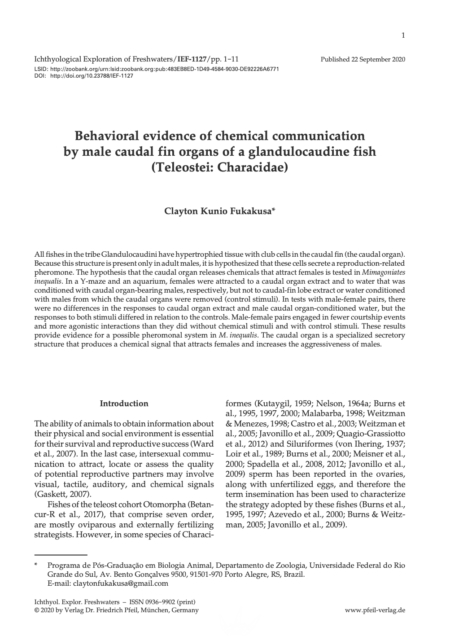

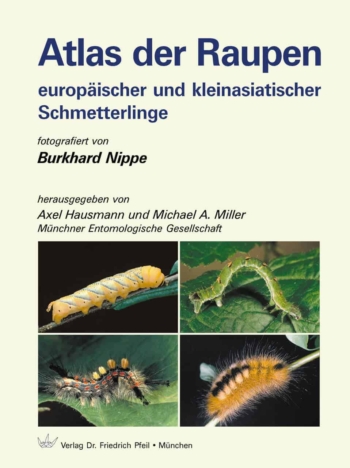
Rezensionen
Es gibt noch keine Rezensionen.